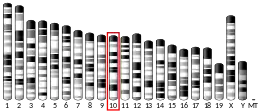| TJP3 | |||||||||||||||||||||||||||||||||||||||||||||||||||
|---|---|---|---|---|---|---|---|---|---|---|---|---|---|---|---|---|---|---|---|---|---|---|---|---|---|---|---|---|---|---|---|---|---|---|---|---|---|---|---|---|---|---|---|---|---|---|---|---|---|---|---|
| |||||||||||||||||||||||||||||||||||||||||||||||||||
| Identifiers | |||||||||||||||||||||||||||||||||||||||||||||||||||
| Aliases | TJP3, ZO-3, ZO3, tight junction protein 3 | ||||||||||||||||||||||||||||||||||||||||||||||||||
| External IDs | OMIM: 612689 MGI: 1351650 HomoloGene: 8458 GeneCards: TJP3 | ||||||||||||||||||||||||||||||||||||||||||||||||||
| |||||||||||||||||||||||||||||||||||||||||||||||||||
| |||||||||||||||||||||||||||||||||||||||||||||||||||
| |||||||||||||||||||||||||||||||||||||||||||||||||||
| |||||||||||||||||||||||||||||||||||||||||||||||||||
| Wikidata | |||||||||||||||||||||||||||||||||||||||||||||||||||
| |||||||||||||||||||||||||||||||||||||||||||||||||||
Tight junction protein ZO-3 is a protein that in humans is encoded by the TJP3 gene.[5]
Interactions
TJP3 has been shown to interact with tight junction protein 1.[6]
References
- 1 2 3 GRCh38: Ensembl release 89: ENSG00000105289 - Ensembl, May 2017
- 1 2 3 GRCm38: Ensembl release 89: ENSMUSG00000034917 - Ensembl, May 2017
- ↑ "Human PubMed Reference:". National Center for Biotechnology Information, U.S. National Library of Medicine.
- ↑ "Mouse PubMed Reference:". National Center for Biotechnology Information, U.S. National Library of Medicine.
- ↑ "Entrez Gene: TJP3 tight junction protein 3 (zona occludens 3)".
- ↑ Wittchen ES, Haskins J, Stevenson BR (December 1999). "Protein interactions at the tight junction. Actin has multiple binding partners, and ZO-1 forms independent complexes with ZO-2 and ZO-3". The Journal of Biological Chemistry. 274 (49): 35179–85. doi:10.1074/jbc.274.49.35179. PMID 10575001.
Further reading
- Roh MH, Liu CJ, Laurinec S, Margolis B (July 2002). "The carboxyl terminus of zona occludens-3 binds and recruits a mammalian homologue of discs lost to tight junctions". The Journal of Biological Chemistry. 277 (30): 27501–9. doi:10.1074/jbc.M201177200. PMID 12021270.
- Kausalya PJ, Reichert M, Hunziker W (September 2001). "Connexin45 directly binds to ZO-1 and localizes to the tight junction region in epithelial MDCK cells". FEBS Letters. 505 (1): 92–6. doi:10.1016/S0014-5793(01)02786-7. PMID 11557048. S2CID 13489358.
- Itoh M, Furuse M, Morita K, Kubota K, Saitou M, Tsukita S (December 1999). "Direct binding of three tight junction-associated MAGUKs, ZO-1, ZO-2, and ZO-3, with the COOH termini of claudins". The Journal of Cell Biology. 147 (6): 1351–63. doi:10.1083/jcb.147.6.1351. PMC 2168087. PMID 10601346.
- Wittchen ES, Haskins J, Stevenson BR (December 1999). "Protein interactions at the tight junction. Actin has multiple binding partners, and ZO-1 forms independent complexes with ZO-2 and ZO-3". The Journal of Biological Chemistry. 274 (49): 35179–85. doi:10.1074/jbc.274.49.35179. PMID 10575001.
- Haskins J, Gu L, Wittchen ES, Hibbard J, Stevenson BR (April 1998). "ZO-3, a novel member of the MAGUK protein family found at the tight junction, interacts with ZO-1 and occludin". The Journal of Cell Biology. 141 (1): 199–208. doi:10.1083/jcb.141.1.199. PMC 2132714. PMID 9531559.
This article is issued from Wikipedia. The text is licensed under Creative Commons - Attribution - Sharealike. Additional terms may apply for the media files.




